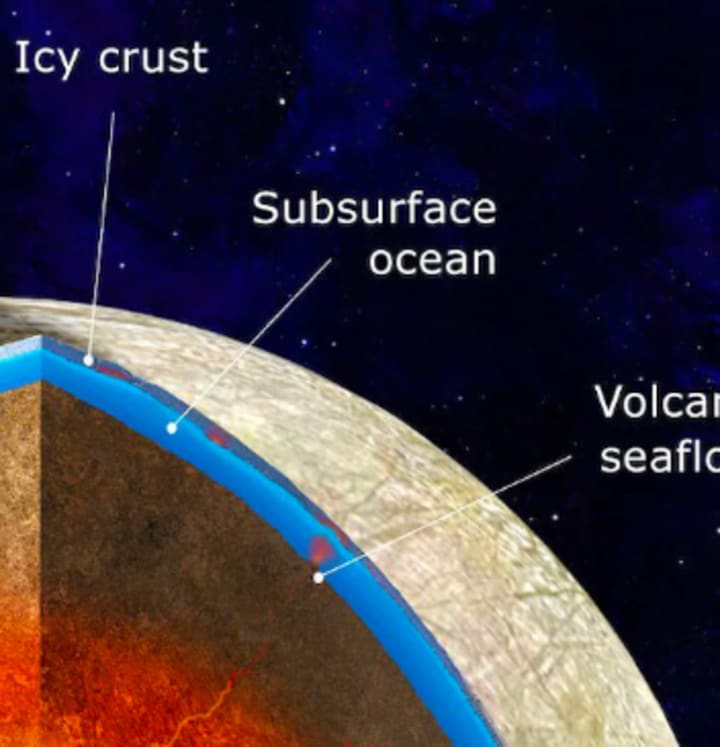NASA Discovers Oxygen for 10 Lakh Humans
NASA's Juno Spacecraft Discovers Potential Habitability on Jupitars Moon Europa

In recent news, Nasa's spacecraft June has found sign of habitability on Jupiter's moon Europa.
The Juno spacecraft, launched by NASA and reaching Jupiter on July 4, 2016, aims to provide scientists with comprehensive insights into the gas giant's weather patterns, magnetic field, and origins through detailed study.
Following the Galileo spacecraft's orbit around Jupiter from 1995 to 2003, Juno marks the second long-term mission to the gas giant. Juno's planned mission duration spans five years, with its anticipated end date, including a controlled impact into Jupiter, scheduled for 2021.
Jupiter's Moon Europa Has Produced Oxygen
Recent research has unveiled Europa, one of Jupiter's intriguing moons, as a significant oxygen producer, potentially offering insights into extraterrestrial habitability.
Oxygen Output Comparable to Human Needs
According to NASA, Europa's icy surface has been found to churn out an impressive volume of approximately 1,000 tons of oxygen every 24 hours. Such a substantial output could theoretically sustain the breathing needs of a million humans for a full day.

Data from NASA's Juno Mission
The groundbreaking findings have stemmed from data acquired through NASA's Juno mission, a spacecraft currently orbiting Jupiter. This mission has provided invaluable data, shedding light on various aspects of the gas giant's moons.
New Calculation Methodology
Scientists have refined their estimation of oxygen production on Europa's surface, leveraging insights gleaned from Juno's Jovian Auroral Distributions Experiment (JADE) instrument. This methodology has offered a more accurate depiction of Europa's oxygen generation rate.
Revised Oxygen Production Rate
However, previous estimates, which suggested an oxygen production rate exceeding 1,000 kilograms per second, have been significantly revised downward. The new calculation indicates a more modest production rate of 12 kilograms per second.

Potential Implications for Life
Intriguingly, scientists have speculated that the oxygen generated on Europa may have permeated its subsurface ocean, potentially serving as a vital energy source for microbial life forms, if they exist.
Understanding Europa's Environment
Europa's unique environment has been characterized by its icy surface, bombarded by charged particles from Jupiter's magnetic field. This continuous bombardment has contributed to the erosion of Europa's icy shell, releasing oxygen and hydrogen.
Juno's Data Collection
The Juno spacecraft has played a pivotal role in data collection, particularly during a close flyby on September 29, 2022. During this encounter, Juno's instruments have measured hydrogen, a byproduct of Europa's oxygen production process.
Continued Exploration
Scientists have expressed enthusiasm for continued exploration, with Juno's extended mission promising further insights into Europa's habitability potential. Additionally, upcoming flybys offer opportunities for exploration of Jupiter's close ring and polar atmosphere, enriching our understanding of the gas giant's moons and surrounding environment.
Historical Exploration
Throughout history, several spacecraft have journeyed past Jupiter on their way to other destinations within our solar system. Among them are notable missions such as Pioneer 10 and 11, Voyager 1 and 2, and New Horizons.
Despite their brief encounters, these spacecraft have provided tantalizing glimpses into the mysteries of Jupiter and its moons. For instance, New Horizons captured a significant volcanic eruption on Jupiter's moon Io.
However, among these missions, only one ventured to stay for the long haul: Galileo. Launched aboard the space shuttle Atlantis in October 1989, Galileo arrived at Jupiter in 1995, embarking on an eight-year-long odyssey of exploration.
Galileo's groundbreaking discoveries included the detection of potential subsurface oceans beneath the icy crusts of Europa, Callisto, and Ganymede. Additionally, Galileo's descent probe delved deep into Jupiter's turbulent atmosphere, yielding invaluable insights into the gas giant's complex dynamics.
Now, NASA's Juno spacecraft has taken up the mantle of unraveling Jupiter's secrets. With a singular focus on the gas giant, Juno aims to address fundamental questions about Jupiter's composition, atmosphere, and magnetic field.
Among its objectives, Juno seeks to determine the abundance of water within Jupiter's atmosphere, shedding light on the origins of our solar system.
Moreover, Juno aims to characterize Jupiter's atmospheric properties across various layers, including gas composition, temperature, and cloud dynamics, offering valuable insights into the atmospheric dynamics of gas giants both within our solar system and beyond.
I hope you like this information. Share with someone who would love to read this.
About the Creator
Ryn Hussain
Welcome to How2guide, your go-to destination for all things tech! Visit Costume PlayHub for Cosplay Enthusiasts.






Comments
There are no comments for this story
Be the first to respond and start the conversation.